|
|
OUR PUREBRED INDIAN
HORSES
|
We believe that it is of utmost
importance to preserve Indian breeds of horses. In order to do so an
effort has been made to maintain pure blood line of India breeds. In
addition to this, the qualities of Indian breeds are
to be brought in focus and high lighted. Only then will they get patronage
resulting in economic viability and support. For the last 50 years Indian
breeds have fallen in a state of neglect due to lack of patronage. Horses
were a mode of fast communication on country tracks and cross country
routes.
|
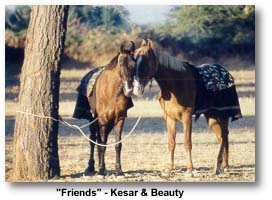
|
|
With the coming of roads, trains, cars and buses the horses fell
into disuse. The three patrons left namely - Races, Polo and the Armed
forces, all three mostly use thorough or half breeds but NOT pure Indian
breed horses.
|
|
There are three predominant breeds of Indian horses
in north west India namely the MARWARI, KATHIAWADI and SINDHI. The Marwar
region (erstwhile Jodhpur State) of Rajasthan has been the home of the
MARWARI breed. The Kathiawadi comes from desertic tract of our neighboring
state Gujrat called Kathiawar. Most areas where the SINDHI
breeds are found have now gone in the SINDH Province of
Pakistan.
|
|

|
In our stables we
have mainly the MARWARI horses and a few Kathiawari and Sindhi horses. The
Marwaris were the traditional battle horses of Rajputana. Our stallion
BADSHAH PASAND is a black Marwari of outstanding points. We do not keep or
use any thorough bred or half bred European horses.
Participation
in our Safari offers a unique chance to horse lovers from all over the
world to ride pure bred Indian horses and to know how
different they feel and handle in cross country riding.
|
BASIC DIFFERENCE BETWEEN
INDIAN AND THOROUGH BRED HORSES
|
Indian breeds of horses are lean
and smaller in built, girth and height as compared to thorough breeds. As a
result they require much less feed and fodder. The hair coat is not so
dense as we have a warm climate. the ear points are pointed and meet,
specially in Marwari and Kathiawari breeds. The hoof diameter is much less and the pastern and fetlock joints
are very flexible. As a result of this, our horses show a natural much
higher capability of clearing obstacles while cross country riding.
|
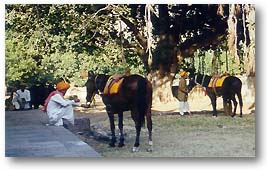
|
Horses
of Indian breeds are very spirited and respond to commands very promptly
after they recognize the riders capability. They are very intelligent and
the rider establishes a very friendly rapport with his steed after some
time.
However because of this lively
temperament it becomes essential that the riders stay at the Roop Niwas
Palace for two or three days and ride for short distance before the Safari
commences. This will enable guests to get accustomed then choose and
change horses as per riding convenience.
HORSES IN OUR
STABLES
|

|
We have 32 horses in our stables
at Roop Niwas Kothi, Nawalgarh. Thus on a safari we need not
borrow horses from other stables. As a result all horses are compatible to
each other while riding .
|
|
Our horses have very interesting names
which are translated hereunder to give you the local flavor. Kesar
(Saffron), Chandrika (moon beam), DAKHI (A raisin - She is as sweet and is
the color of a raisin), CHABILI (naughty and flamboyant), RADHA PRIYA
(Dear to Radha Rani in the eternal service of Lord Krishna), DIL PANSAND
(adored by my heart), NAYAN SUKH (which give pleasure to our eyes when we
gazeat it), CHAND (moon). Some of the young fillies which are yet to be
named are affectionately christened by our guests as they do their
first safari. Respecting their sentiments they carry the name for life-e.g. BEAUTY, SARAH,
NABILA, ZIA . Our Stallions of pure Marwari breed
are called BADSHAH PASAND. (Liked by the Emperor), ALAM GUMAN (pride of the
sky).
|
OUR SADDLER
|
Our saddles are the Indian
cavalry "SAWAR" saddles. They are strong,
simple comfortable riding saddles, as were used in the British cavalry in
India. The same design is still used in the Indian cavalry
regiments. These saddles are not only
comfortable for the riders, but they are equally comfortable for the
horses.
|
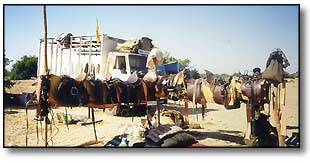
|
|
This is because the design permits circulation of air
between the saddle and the back of the horse. his ensures that the
back of the horse does not get soar even after long rides. It is advisable for any riders
with medical situation to get their own sheep skin which can be easily put
over the "Sawar" Saddles. Riders are also requested to get their
riding chaps, helmets and boots. As the boot size varies guests may
get their stirrups to avoid any problem in usage of the standard size
stirrups provided by us. All tack is kept in excellent
condition.
|
RIDING
ABILITY
In order to enjoy this trip you
have to be fit and a confident rider on all paces.
PACE OF
RIDE
Walk, trot and when terrain
permits long canters.
RIDING
SCHEDULE
Departure from starting point or
camp site is approximately at 8.30 / 9.00. A.M. after breakfast carrying
packed lunch. After 2 - 3 hours of riding including visit of interesting
villages enroute, lunch halt is made around 12 noon. The afternoon is a
shorter ride approximately 2.00 to 4.00 p.m. The Kitchen staff has by this
time moved by Truck/Jeep and set up camp. They have tea ready when the
party arrives.
Riding distances are restricted
between 25 -40 Kms. per day. Riding time is broken into two by a long
lunch halt with special demonstrations like turban tying, hair cut by
expert barber who creates designs of flowers, birds on flat parts
of horse/camels, folk music etc.
A Jeep carries soft drinks,
beverages in a ice box (The box might just have cold water from a "MATKA"
placed outside in the camp courtyard the previous night if Ice is not
available in 30 Kms. radius). A accompanying musician and also baggage of
guests is carried on this Jeep which meets the guests at lunch
spot.
OUR
CAMELS
|
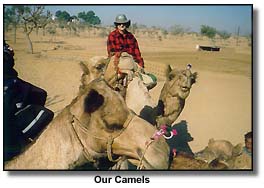
|
In Rajasthan we have the single
hump drumdairis, called 'camel' in spoken language. The
Bikaner and Jaisalmer breed is being used by us. Each camel saddle has two
distinct seats one ahead of the hump and one behind the hump. Each camel
has a driver. He controls the animal and the only thing you have to do is
to remain in your saddle. Once proficiency is gained controls can be taken
over.
THE PACE OF RIDE - Walk & slow trot.
|
Go top
LUNCH
|
We use services of an ex army
cook who all his life has given many pack lunches to officers
moving with the Paltans. In army language it is called "HAVER SACK". He
turns out the most amazing variety of menus. No two lunches have
a common menu. Instead of giving individual lunch boxes, a buffet is laid
out. Tea/Coffee is served piping hot in insulated containers.
Portable stools are carried in the Jeep, to be used by the guests at
Lunch time.
|
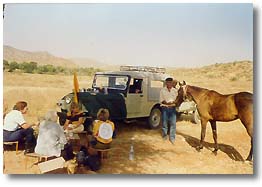
|
|
The services of a groom is
provided in the ratio of, one groom for three horses. The groom does
saddling and unsaddling every day - feeds and waters the horses. He gives
the horses a sand bath and grooms the horses when required.
A outrider and a English speaking
leader escorts the Safari, whenever any rider requires help a whistle is
blown. Hearing this all riders come to a stand still and the outrider goes
and attends the rider requiring assistance.
Go top
|
OUR
LUXURY ORIENTAL CAMPS
|
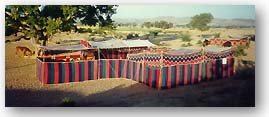
|
|
Our Camp consists of Tented
accommodation in Shamiana type oriental tents on twin
sharing / single basis. Each tent cubicle is provided with cots, chairs,
linen, white sheets, quilts, blankets, pillows, mosquito nets, hot water
bottles and a full floor covering , lighting in tents is by kerosene
lamps. The dinning tent and kitchen are lit by petromex / gas
lamps.
|
|
|

|
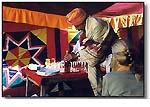
|
|
|
We have our own
toilet and bath tents. These are one piece units with a covered roof and
zippers. The bath tents have wooden floor,
foot mats and hangers for clothes. The toilet tents have a wooden / metal
commode with a pit. Hot water for bath is provided in buckets both in the
morning and evening. There is a provision of soaps, towels, looking
mirrors and wash basin.
Go top
|
DINING
AREA
|
The dining tent has regular sit
down arrangement with chairs and tables. Fixed menu meals with a choice of
Indian and continental dishes in every meal are provided. Tea and coffee
after each meal and soup at Dinner is for unlimited consumption. The camp is laid down leaving a
large rectangular courtyard for camp fires and folk entertainment. The
dining tent is on one width while the other three sides are guest
tents. The adjacent space being utilized for bath and toilet
tents.
|
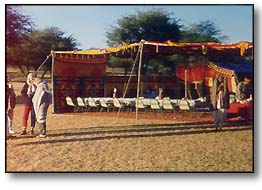
|
|
The camp gives a very colorful
look and reminds one of a Royal camp in the days of the Maharajas and the
British Rule. The kitchen tent and staff tent are pitched at a little
distance. The horses also get wind breakers and open tents where
required.
Go top
|
Our safaris normally operate
October through March. these are very pleasant winter months of the Indian
weather cycle. Daytime in the second half of March does warm up a bit, the
nights remain cool. Guests joining our March safari are amply rewarded by
the fantastic Balotra horse fair. The Balotra fair is one of its own kind
in the world.
|
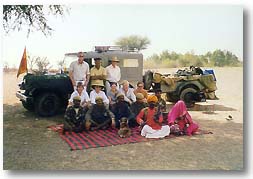
|
NON RIDER SPOUSES AND FRIENDS NOT TO BE LEFT OUT THEY COULD
BE MEMBERS JOINING THE SAME SAFARI IN A JEEP.
Additional
non riders join the group using all service, but commuting in a jeep. This
enables non rider spouses / friends to holiday together .
|
SALIENT POINTS WHICH MAKE OUR SAFARI MORE ENJOYABLE
AND COMFORTABLE THEN OTHERS.
Camping sites are well chosen
and offer superb view of the country side even if it requires additional
cost to transport water by camel cart tanks to the camp site.
All horses being from the same
stable are compatible to each other.
We insist that the guests
arrive 2-3 days before the Safari at Roop Niwas Palace Nawalgarh or the starting point. Here they are provided
horse rides which enables them to pick, choose and change horses as per
their capabilities. No charges are made for these 2-3 days of
horse riding.
While on Safari spare horses
accompany the contingent. In case of any horse going lame or any
other reason a guest gets his horse replaced immediately.
We invite other horse
enthusiasts / riders from local areas to be our guests for 2-3 days
portions of the 'Safari' . Guests have very interesting interaction with
these native horse lovers. The cost of these invitees is borne by
us.
Every evening and Lunch time
talks and  demonstrations
are organized as per the guests interest. Topics of talks could vary
from local horse medicine, wild life , caste system to philosophy . The
demonstration could be on Indian cooking or to preparing jute reins for
your horse. demonstrations
are organized as per the guests interest. Topics of talks could vary
from local horse medicine, wild life , caste system to philosophy . The
demonstration could be on Indian cooking or to preparing jute reins for
your horse.
We have our own fleet of
vehicles which includes three large trucks, one mini-truck, one four
wheel drive jeep/trailer, one tractor/trolley, and camel cart
water tanks which enables us to operate efficiently.
Go top
All our Safaris are personally
accompanied by Bhanwar Devendra Singh & Durga Singh and the
team.
GUESTS IMMENSELY
ENJOY:
Folk music and open
discussions held around the camp fire.
A massage after a long day of
riding.
Trying out their recepies on
the campfire and sharing it with others on any one day of the
safari.
Visiting a private home during
the ride and meeting the family.
Indian cosmetic techniques
like Henna application for the ladies.
USEFUL THINGS TO BRING
ALONG ON THE SAFARI
Chaps & riding
helmets.
Sheep skin.
Small soft water bottle to go
into you saddle bag.
Light wind proof rain
coats.
Flash light.
Sun protection hats.
Bathing gowns for
ladies.
WHAT IT
COSTS
Our horse safaris cost a average
of US$ 200.00 to US$ 260.00 per person per day. This rate is full board
including all riding activities.
Pre and post safari
tours/drinks/transfers/gratuities and personal insurance is excluded.
You do not need any horse
insurance for our horses.

| |

